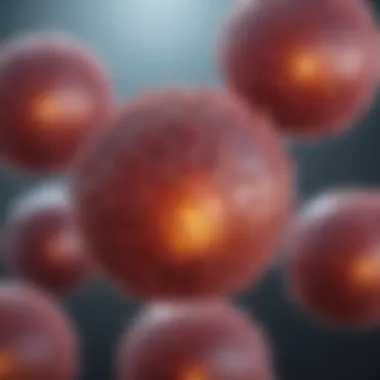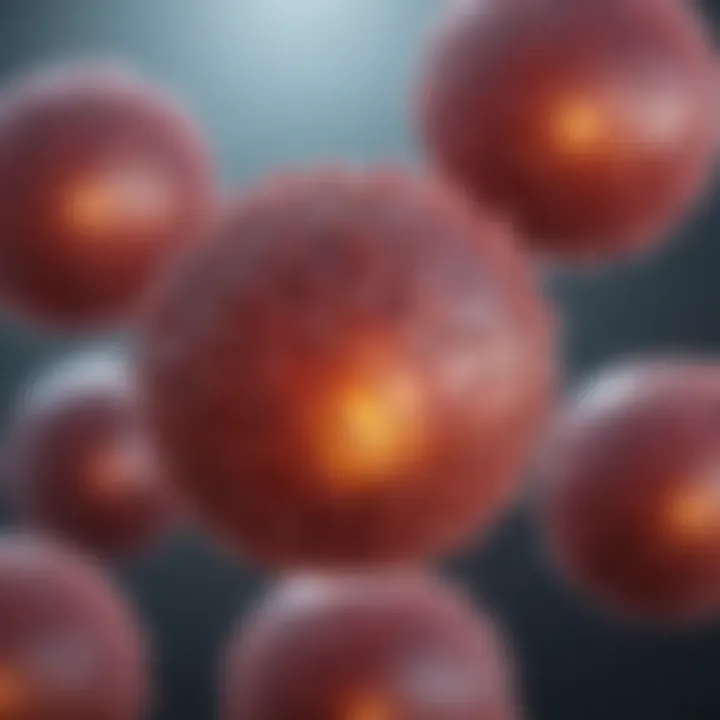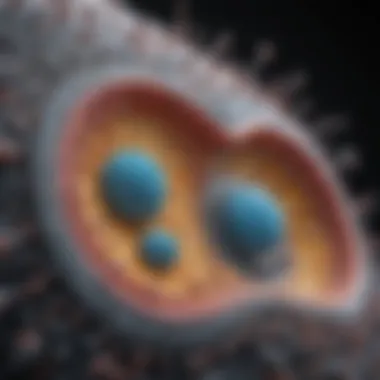Exploring the Membrane Integrity Factor in Biology


Intro
The concept of membrane integrity factor is of paramount importance in both biological and chemical contexts. Understanding the mechanisms that dictate membrane integrity is crucial for various applications, ranging from cellular health to industrial processes. This examination aims to distill the essential elements of membrane integrity, providing insight into its relevance in modern research.
Research Overview
Key Findings
The exploration of membrane integrity factor has led to several key findings:
- Membrane integrity is vital for cell viability and function.
- Deterioration of membrane integrity correlates with various pathologies.
- Assessment techniques such as fluorescence microscopy and dye exclusion methods are effective in evaluating membrane status.
- Understanding membrane integrity can guide the development of therapies targeting cellular function.
These findings underscore the necessity for continued research in this area, highlighting how membrane integrity directly impacts biological systems and therapeutic strategies.
Study Methodology
To investigate the membrane integrity factor, recent studies have utilized both experimental and analytical methodologies. Common approaches include:
- Fluorescence microscopy: This technique allows researchers to visualize membrane integrity by using fluorophores that signal compromised membranes.
- Dye exclusion assays: Certain dyes can indicate membrane integrity through selective permeability, providing quantitative data on membrane condition.
- Cellular assays: These assess cell viability and functionality following membrane disruption, linking integrity metrics to biological outcomes.
The combination of these methodologies provides a comprehensive understanding of the factors influencing membrane integrity.
Background and Context
Historical Background
The exploration of membrane integrity has its roots in cellular biology. Early researchers recognized the significance of the cell membrane as a barrier essential for life. Over time, the study evolved, especially with the advent of technologies such as electron microscopy in the mid-20th century, which allowed for detailed observation of cellular structures. This historical perspective lays the groundwork for contemporary understandings.
Current Trends in the Field
Currently, there is an increasing focus on the implications of membrane integrity in various fields. Some notable trends include:
- Therapeutic applications: Innovation is directed at understanding how membrane integrity influences drug delivery and therapeutic efficacy.
- Biotechnological advancements: Researchers are looking into how manipulating membrane integrity can enhance fermentation processes and bioproduct yields.
- Environmental impact: Studies are also expanding into how membrane integrity affects microbial interactions in ecological systems.
These trends highlight the dynamic nature of research surrounding membrane integrity, reinforcing its significance across multiple domains of science and technology.
Membrane integrity is not just a fundamental concept; it is the nexus of cellular function, health, and therapeutic innovation.
Overall, a thorough understanding of membrane integrity factor enables researchers and practitioners to navigate the complexities of biological systems with heightened awareness.
Prelude to Membrane Integrity Factor
Understanding the membrane integrity factor is essential for comprehending various biological processes and applications. Membrane integrity is a critical aspect of cellular function, as it directly influences how cells interact with their environment, including nutrient uptake and waste removal. By examining the integrity of membranes, researchers can gain insights into cellular health, which is vital for numerous fields such as biochemistry, pharmacology, and biotechnology.
The concept of membrane integrity factor encompasses several dimensions. It provides a baseline for evaluating the stability of cellular membranes under varying conditions. This evaluation is fundamentally important for both basic research and applied sciences, particularly in the context of disease mechanisms and therapeutic strategies. When membranes remain intact, they effectively maintain homeostasis within the cellular environment. Conversely, compromised membranes can lead to dysfunctional cellular processes or, even worse, cell death.
In this section, we will explore the definition of membrane integrity factor and its significance in various contexts, from fundamental research to practical applications in medicine and industry.
Definition and Importance
The membrane integrity factor can be described as a quantitative measure that reflects how well a biological membrane preserves its structure and function over time. This concept is rooted in the understanding that membranes are not merely barriers; they play a dynamic role in facilitating communication and transport within and outside the cell.
The importance of maintaining membrane integrity cannot be overstated. Here are several key aspects:
- Cellular Function: Membranes regulate the entry and exit of ions, nutrients, and other molecules. Membrane integrity is vital for maintaining the proper physiological conditions within the cell, ensuring that cellular processes operate efficiently.
- Reactivity to Environmental Stressors: Cells frequently face environmental challenges such as temperature fluctuations, pH changes, and toxic agents. A robust membrane structure can help mitigate damage from these stressors, thereby sustaining cellular health.
- Disease Correlation: A loss of membrane integrity is observed in various diseases, including cancer and neurodegenerative disorders. Understanding how membranes become compromised can lead to new diagnostic and therapeutic avenues.
- Applications in Biotechnology: In bioprocessing, the performance of membranes in separating and purifying products relies on their integrity. This is critical for optimizing efficiency and reducing operational costs.
In summary, delving into the membrane integrity factor equips researchers and practitioners with the knowledge necessary to address challenges in both biological studies and applied sciences. Through continued exploration of this concept, we can enhance our understanding of life processes at the cellular level and create more effective applications across multiple disciplines.
Fundamental Principles of Membrane Integrity
Membrane integrity is essential for maintaining the function of cells in any biological system. The principles behind membrane integrity detail how cells interact with their environment and the mechanisms that preserve their structural stability. Understanding these principles proves crucial for various fields, including biology, medicine, and biotechnology. Two main aspects come to the forefront in this discussion: the composition of the membranes and the physical properties that contribute significantly to their integrity.
Membrane Composition


Membranes are not uniform; they consist of various components that contribute to their unique properties. The primary building blocks of biological membranes are phospholipids, cholesterol, and proteins.
- Phospholipids form the basic structure of the membrane. They possess both hydrophilic (water-attracting) and hydrophobic (water-repelling) properties that allow them to arrange themselves into a bilayer. This bilayer acts as a barrier, regulating what enters and exits the cell.
- Cholesterol is interspersed among the phospholipids. It plays a vital role in maintaining membrane fluidity, allowing membranes to remain functional across varying temperatures. An optimal level of cholesterol is important; too much or too little can disrupt membrane stability.
- Proteins embedded in the membrane serve various functions, from facilitating transport to acting as receptors for signaling molecules. The presence and type of proteins can significantly affect the membrane's robustness and responsiveness to external stimuli.
The intricacy of membrane composition is a vital consideration when discussing integrity. Disruption in any of these components can result in a loss of functionality, indicating the importance of maintaining the delicate balance within the membrane structure.
Physical Properties of Membranes
The physical characteristics of membranes are as important as their chemical compositions when it comes to integrity. Several key properties ensure membranes remain functional and intact.
- Fluidity is crucial. Membranes must retain a certain level of fluidity to allow for the proper function of embedded proteins and the movement of molecules. Membrane fluidity can be affected by temperature, composition, and the presence of specific fatty acids.
- Permeability determines what substances can pass through the membrane barrier. A membrane that is too permeable may allow unwanted materials to enter while failing to retain essential molecules. Conversely, a less permeable membrane may hinder nutrient transport.
- Tension and flexibility also play roles. Membranes must withstand various physical stresses without rupturing. In addition, flexibility aids in the fusion processes necessary for transport and communication between cells.
"The stability of cellular membranes is pivotal to all life forms; any compromise can lead to significant cellular dysfunction."
Overall, the fundamental principles of membrane integrity encompass both the complex makeup of the membrane and the physical properties that allow it to function effectively under various conditions. Understanding these principles is crucial not only for academic research but also for practical applications in medicine and biotechnology.
Measuring Membrane Integrity
The measurement of membrane integrity is a crucial aspect in the study of biological systems. It provides insights into cellular health, influencing various applications in research and industry. Assessing membrane integrity helps to determine how well a cell maintains its internal environment and how it responds to external stresses. Understanding these factors is vital for researchers and practitioners aiming to improve processes in biotechnology, pharmacology, and medical diagnostics.
Standard Techniques
Standard techniques for measuring membrane integrity include methods such as trypan blue exclusion, viability assays, and lactate dehydrogenase (LDH) release assays. Each technique offers distinct advantages and considerations.
- Trypan Blue Exclusion: This method relies on the principle that live cells exclude the dye, whereas dead cells take it up. It is straightforward and can provide quick results, but it only gives a snapshot of viability at a single moment.
- Viability Assays: Here, various reagents like MTT or Alamar Blue are used to assess metabolic activity, indirectly reflecting membrane integrity. These assays often provide more quantitative data than trypan blue.
- LDH Release Assays: This method measures the release of lactate dehydrogenase from damaged cells. An increase in LDH in the culture medium indicates compromised membrane integrity. This technique has higher sensitivity but may not equally represent cell viability.
Innovative Approaches
Innovative approaches have recently emerged to enhance the accuracy and reliability of measuring membrane integrity. These techniques include imaging cytometry and nanoparticle-based biosensors.
- Imaging Cytometry: This method combines traditional cytometry with advanced imaging. It allows for high-throughput assessment of cell populations, enabling researchers to visualize membrane integrity at the single-cell level.
- Nanoparticle-Based Biosensors: Recent advancements in nanotechnology have paved the way for biosensors that utilize nanoparticles to detect changes in membrane integrity. These sensors can provide real-time monitoring of cell health in dynamic environments, which can be especially beneficial in pharmaceutical and clinical applications.
Emphasizing the need for accurate measurements, innovative techniques have the potential to significantly advance the understanding of membrane integrity in various fields.
In summary, measuring membrane integrity is essential for comprehending cellular function and health. Both standard and innovative techniques serve specific purposes, each contributing to a deeper understanding of how membranes perform in biological settings.
Factors Affecting Membrane Integrity
The integrity of biological membranes is crucial for maintaining cellular functions and overall organism health. Understanding factors that influence membrane integrity helps us develop better strategies for preserving it. These factors include environmental conditions, chemical agents, and biological stressors, each playing a significant role in the stability and functionality of membranes. Their impact must be studied comprehensively to address various biological and technical challenges.
Environmental Conditions
Membranes are sensitive to changes in environmental conditions. Temperature, pH, and osmotic pressure can profoundly influence membrane structures and functions.
- Temperature: Elevated temperatures can increase membrane fluidity, which may lead to destabilization. Conversely, low temperatures can make membranes too rigid.
- pH Levels: Changes in pH affect the ionization status of membrane components. This alteration can disrupt the interactions between lipids and proteins, potentially compromising membrane integrity.
- Osmotic Pressure: When cells are exposed to high osmotic pressures, water movement can affect the membrane's physical state.
A deep understanding of these conditions allows scientists to predict how membranes behave under various environmental influences.
Chemical Agents
Chemical agents can drastically affect membrane integrity. These agents can be broadly classified into surfactants, solvents, and certain reactive compounds.
- Surfactants: These compounds can reduce surface tension and disrupt lipid bilayers, leading to increased permeability. This action can be beneficial for drug delivery, but it may have detrimental effects on cell membranes.
- Solvents: Organic solvents can penetrate lipid bilayers, compromising membrane structure and function. Their effects are dose-dependent, meaning that even low concentrations can have significant outcomes
- Reactive Compounds: Certain chemicals like free radicals can induce oxidative stress, leading to membrane lipid peroxidation. This process damages the lipids and can ultimately result in cell death.
Considering the impact of these chemicals is essential for applications in drug formulation and biomaterials.
Biological Stressors
Biological stressors include factors such as pathogen invasion, immune response, and cellular aging, all of which can affect membrane integrity.
- Pathogen Invasion: Bacteria and viruses can compromise membranes by producing enzymes that degrade lipids or proteins. These actions can impair functions and signal transduction pathways.
- Immune Response: During inflammation, immune cells release cytokines and enzymes that can impact surrounding healthy membranes. This effect can exacerbate symptoms in various diseases.
- Cellular Aging: As cells age, changes in membrane composition occur. For instance, there is an increase in cholesterol and decrease in unsaturated fats, which may result in decreased fluidity and function.
"Recognizing these stressors provides insights into how diseases develop and how therapeutic interventions can be tailored."
By understanding these factors, researchers can develop better diagnostic tools and therapeutic strategies aimed at maintaining membrane integrity in various biological and medical contexts.


Role of Membrane Integrity in Cellular Function
The concept of membrane integrity plays a crucial role in cellular function. The cell membrane acts as a barrier that separates the interior of the cell from the external environment. This separation is vital for maintaining homeostasis, which is necessary for the survival of the cell and the organism as a whole. When membrane integrity is compromised, a cascade of detrimental effects can follow, impacting various cellular processes.
Transport Mechanisms
Transport mechanisms are fundamental to how cells manage nutrients and waste products. The cell membrane is selectively permeable, meaning it allows certain substances to pass while blocking others. This characteristic is essential for processes such as:
- Passive Transport: Includes diffusion and osmosis, whereby substances move along their concentration gradient without energy expenditure.
- Active Transport: Requires energy to move substances against their concentration gradient. This process is facilitated by specific proteins embedded in the membrane.
- Endocytosis and Exocytosis: These mechanisms involve the membrane engulfing substances to bring them into the cell or packaging them for expulsion from the cell.
These transport mechanisms rely on the integrity of the membrane. If membranes become damaged or lose their structural integrity, the efficiency of these transport systems decreases. This can lead to nutrient deficits or toxic accumulation of waste within the cell.
Signal Transduction
Signal transduction is another critical function of the membrane, allowing cells to communicate with each other and respond to their environment. Membrane receptors are proteins found in the lipid bilayer that recognize and bind to signaling molecules. This binding triggers a series of intracellular events that result in a cellular response. Important aspects include:
- Ligand-Receptor Interactions: Specific ligands bind to receptors, causing conformational changes that transmit signals.
- Second Messengers: These are small molecules that propagate the signal inside the cell, amplifying the response to the initial signal.
- Activation of Kinases: Enzymes that add phosphate groups to target proteins, modulating their activity and affecting various cellular processes.
Membrane integrity is vital for these signaling pathways. Disruptions in the membrane can lead to altered signal transduction, resulting in impaired cellular responses. This is critical to understanding various pathological conditions where membrane integrity is compromised.
"Membrane integrity underpins essential cellular functions, making it a focal point of study in both normal physiology and pathology."
Membrane Integrity in Pathology
Membrane integrity plays a crucial role in understanding various disease processes. When cellular membranes are compromised, it can lead to significant pathophysiological consequences. This section discusses how membrane integrity is affected in diseases and the implications of such changes.
Disease Mechanisms
Membrane integrity is fundamental to cell survival. Damage to cellular membranes can initiate a cascade of pathological events. For instance, consider the following:
- Inflammation: Cytokines can alter membrane permeability, allowing harmful substances to enter cells.
- Autoimmune Disorders: In diseases like multiple sclerosis, antibodies can target and disrupt myelin sheath integrity, impairing nerve function.
- Cancer: Malignant cells often exhibit disrupted membrane structures that facilitate invasion into surrounding tissues.
When membranes lose their integrity, cells become less capable of regulating ion exchange and nutrient uptake. This can lead to cellular necrosis or, in some cases, apoptosis. Hence, understanding these mechanisms is critical for developing therapeutic strategies.
Cell Death and Membrane Integrity
Cell death mechanisms, especially necrosis and apoptosis, are closely tied to the integrity of cellular membranes. Membrane permeability changes can indicate the type of cell death occurring.
- Necrosis: In necrotic cells, membranes rupture, causing cell contents to spill out. This process can trigger inflammatory responses, exacerbating tissue damage.
- Apoptosis: In contrast, during apoptosis, membrane integrity is maintained until specific signals prompt the cell to break down. This orderly process prevents inflammation and allows for the removal of dying cells without harming surrounding tissues.
"Membrane integrity influences not only the fate of individual cells but also the broader tissue response to injury or disease."
Overall, maintaining membrane integrity is vital for cellular function and survival in the context of disease. Disruptions can lead to severe repercussions, including chronic inflammation and organ dysfunction. Understanding these relationships not only aids in diagnostics but also informs treatment approaches.
Therapeutic Implications
The concept of Membrane Integrity Factor is pivotal in therapeutic applications, influencing the design and efficacy of numerous medical interventions. This aspect allows researchers and practitioners to develop strategies that ensure membrane integrity and promote cellular health. Understanding this relationship can yield significant benefits in drug development and innovative technologies aimed at preserving membrane stability.
Drug Development Strategies
Drug development strategies are crucial for ensuring the success of new pharmaceuticals. Membrane integrity is fundamental to the proper functioning of these drugs within biological systems. Maintaining membrane integrity can lead to enhanced absorption and efficacy of drug compounds. Investigating the permeability of membranes helps in optimizing drug formulations. For instance:
- Formulation adjustments: A drug designed to interact favorably with membrane structures can improve its bioavailability.
- Targeted delivery systems: Using liposomes or nanoparticles can facilitate the specific targeting of cells, enhancing therapeutic outcomes without adverse effects on surrounding membranes.
- Stability testing: Evaluating how drugs affect membrane properties during development allows for better understanding of long-term effects and stability.
Researchers should focus on evolutionary methods that mirror natural processes to fine-tune the delivery mechanisms. This approach not only improves efficacy but also reduces the likelihood of membrane disruption.
Nanotechnology in Membrane Integrity Preservation
Nanotechnology offers exciting avenues for preserving membrane integrity. By utilizing nanoscale materials, researchers can design targeted solutions that enhance the understanding and maintenance of membrane structures. Some aspects to consider include:
- Nanoparticles for protection: Engineered nanoparticles can aid in reinforcing or restoring compromised membranes, presenting a protective layer against harmful agents.
- Nanocarriers: These technologies can enhance the delivery of therapeutic agents directly to target cells while minimizing collateral damage to cellular membranes.
- Monitoring techniques: Nanosensors can provide real-time assessments of membrane integrity, facilitating timely intervention when degradation occurs.
"Nanotechnology represents a revolutionary stride in maintaining and repairing membrane integrity, promising breakthroughs in the preservation of cellular health."


The integration of these nanotechnological advances not only maximizes the therapeutic potential of drugs but also ensures that membrane stability is preserved underchallenge.
By recognizing the therapeutic implications of membrane integrity, such strategies enrich the understanding of how to combat various diseases and improve therapeutic outcomes. Engaging in interdisciplinary research will further propel these advancements forward, emphasizing the necessity for continuous innovation in this vital area.
Membrane Integrity in Biotechnological Applications
Membrane integrity is crucial in various biotechnological applications, influencing outcomes across many sectors. These applications range from food science to drug delivery systems. Understanding and maintaining membrane integrity ensures efficiency, safety, and efficacy in bioprocessing and food preservation.
Food Preservation Technologies
In food science, maintaining membrane integrity is fundamental for improving shelf life and quality. Membranes play a vital role in controlling the transfer of moisture, gases, and solutes. Techniques such as ultrafiltration and microfiltration are common in food preservation. They help separate unwanted microorganisms without compromising the nutritional quality of the food.
- Impact on Quality: The integrity of membranes determines how well food retains its taste, color, and texture.
- Safety Concerns: Broken or inefficient membranes can lead to contamination. For instance, pathogens entering food products can cause foodborne illnesses.
- Sustainability: Improved membrane processes reduce the need for chemical preservatives, aligning with modern consumer demands for healthier options.
Methods like osmosis and reverse osmosis also aid in removing undesirable substances while preserving essential nutrients. These technologies ensure that food products maintain a high quality, thus satisfying market expectations. The effectiveness of these technologies emphasizes the necessity of membrane integrity in food preservation.
Bioprocessing Efficiency
In biomanufacturing, where cell cultures or microorganisms are used to produce materials, membrane integrity dictates the success of operations. It enhances productivity and product yield while minimizing costs. Masny factors influence efficiency, including the material of the membranes and their configurations.
- Cell Retention: Membranes must retain cells while allowing metabolites to pass through. Poor integrity can lead to loss of valuable cells and lower yields.
- Process Robustness: Membrane filters should withstand various stress conditions, like fluctuations in temperature or pressure. This robustness directly correlates with the longevity of operations.
- Recovery of Products: Effective membrane technology facilitates the recovery of valuable byproducts, increasing the economic viability of bioprocesses.
In summary, biotechnological applications greatly benefit from strong and effective membrane systems. By ensuring membrane integrity, both food preservation and bioprocessing can achieve higher quality and efficiency. The ongoing development in this area is vital for advancing technologies to meet global needs.
Emerging Research Trends
Emerging research trends in the field of membrane integrity are crucial for informing advancements in various scientific domains. Understanding these trends requires an awareness of the latest methodology and scientific inquiry. Researchers are beginning to recognize the complexity of membrane dynamics, which includes not just structural aspects but also functional and biological implications. Renewed focus on membrane behavior provides fresh insights that are critical to exploring its integrity factors.
New Insights into Membrane Dynamics
Recent studies emphasize the dynamic properties of cellular membranes. These membranes are not static structures; instead, they exhibit flexibility and adaptability. Understanding the fluid mosaic model of membrane structure helps scientists analyze how different components interact, affecting overall membrane function. Key factors such as lipid composition, protein interactions, and the presence of cholesterol are now seen as foundations influencing membrane integrity.
Innovative imaging techniques allow for visualization at the molecular level. Techniques like fluorescence microscopy have revolutionized how researchers study membrane dynamics. It is now possible to observe real-time movement of proteins within membranes. Insights gained from such studies are illuminating how disruptions in this movement can lead to decreased membrane integrity, impacting cellular health.
"The more we understand membrane dynamics, the better we can target pharmaceutical interventions and develop therapies."
The implications of this knowledge extend into areas like drug delivery systems. By fully understanding how membranes can be compromised or maintained, scientists develop more effective strategies to ensure drug efficacy while minimizing potential membrane damage.
Interdisciplinary Approaches
The complexity surrounding membrane integrity has spurred interdisciplinary collaboration among biologists, chemists, engineers, and computational scientists. Each field offers unique perspectives that enrich our understanding of membrane integrity.
- Biology and Chemistry: Researchers investigate the molecular interactions and chemical processes that govern membrane functionality. This includes the study of how certain compounds can alter membrane properties, potentially leading to novel therapeutic strategies.
- Materials Science: The design of synthetic membranes with desirable properties has gained traction. This quest involves improving the durability and selectivity of membranes in processes like filtration.
- Computational Modeling: Advances in computer simulations allow scientists to predict and analyze membrane behavior under varying conditions. This approach is particularly beneficial in understanding how membranes respond to stress or injury at a fundamental level.
These interdisciplinary approaches not only deepen theoretical insights but also lead to practical applications. Addressing the challenges within membrane integrity becomes more manageable when insights from various fields merge. By fostering collaboration, the community can push the boundaries of our understanding, leading to innovative solutions in biotechnology, pharmaceuticals, and environmental sciences.
As the field matures, ongoing research will continue to focus on these promising avenues.
The exploration of membrane integrity is far from concluded; in fact, it is increasingly vital in both academic and industrial sectors.
Finale
The importance of concluding an exploration into the membrane integrity factor cannot be overstated. This section serves as a synthesis of the insights and findings presented throughout the article, providing a cohesive understanding of membrane integrity in various contexts. A well-structured conclusion allows the reader to reflect on the key elements discussed, facilitating a comprehensive grasp of the subject.
Recapping Key Insights
In this article, we navigated various facets of the membrane integrity factor. Key insights include:
- Definition and Relevance: Membrane integrity is crucial for maintaining cellular health. Its assessment directly influences our understanding of biological systems.
- Techniques for Measurement: Various methods, both standard and innovative, offer different perspectives on analyzing membrane integrity. This variety underscores the ongoing exploration in the field.
- Application Across Disciplines: The relevance of membrane integrity spans across biology, pathology, and therapeutic strategies. Each application highlights the complexity and necessity of maintaining membrane integrity for optimal functionalities.
"The condition of biological membranes is a barometer for overall cellular health."
- Emerging Research Directions: Ongoing studies emphasize new insights into membrane dynamics, suggesting that our understanding of membrane behavior is still evolving.
Future Directions in Research
Looking forward, several promising avenues warrant attention. These include:
- Novel Assessment Techniques: Continued innovation in measurement techniques can refine our understanding of membrane integrity.
- Interdisciplinary Studies: Collaboration between biology, chemistry, and technology can yield new findings on membrane dynamics.
- Therapeutic Applications: Investigating how membrane integrity impacts drug delivery systems may reveal potential breakthroughs in medical treatments.
- Environmental Impact: Understanding how external factors influence membrane integrity can inform practices in biotechnology and environmental management.
Overall, the future of membrane integrity research holds the potential for significant advancements, impacting a range of fields from medicine to biotechnology.







